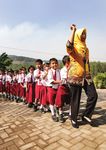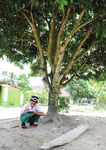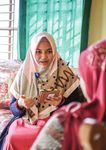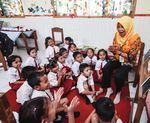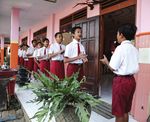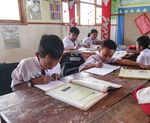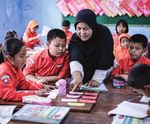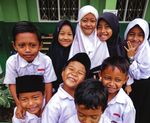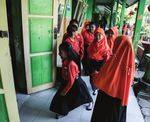The Promise of Education in Indonesia - OVERVIEW Consultation Edition - World Bank Document
←
→
Page content transcription
If your browser does not render page correctly, please read the page content below
Public Disclosure Authorized Public Disclosure Authorized Public Disclosure Authorized Public Disclosure Authorized
The Promise of Education in Indonesia
Consultation Edition
OVERVIEWThis volume is a product of the staff of the International Bank for Reconstruction and Development/The World Bank. The findings, interpretations, and conclusions expressed in this paper do not necessarily reflect the views of the Executive Directors of The World Bank or the governments they represent. The World Bank does not guar- antee the accuracy of the data included in this work. Copyright © 2019 The World Bank The material in this publication is copyrighted. Copying and/or transmitting portions or all of this work without permission maybe a violation of applicable law. The International Bank for Reconstruction and Development/ The World Bank encourages dissemination of its work and will normally grant permission to reproduce portions of this work promptly. For permission to photocopy or reprint any part of this work, please send a request with complete information to the Copyright Clearance Center, Inc., 222 Rosewood Drive, Danvers, MA 01923, USA, telephone 978-750-8400, fax 978-750-4470, http://www.copyright.com/. All other queries on rights and licenses, including subsidiary rights, should be addressed to the Office of the Pub- lisher, The World Bank, 1818 H Street NW, Washington, DC 20433, USA, fax 202-522-2422, e-mail pubrights@ worldbank. org.
Contents
Abbreviations iii
Introduction 1
Education sector diagnostic 7
GOAL 1: Boost learning 12
RECOMMENDATION 1: Ensure that students reach at least minimum learning and development
standards at each level of the system 14
GOAL 2: Provide learning for all 16
RECOMMENDATION 2: Act to improve learning outcomes of the lowest performers 18
GOAL 3: Start early 20
RECOMMENDATION 3: Make quality early childhood education accessible to all 23
GOAL 4: Serve everyone 24
RECOMMENDATION 4: Ensure that all students, including the disabled, succeed 27
GOAL 5: Improve teaching 28
RECOMMENDATION 5: Improve teacher recruitment, training, and professional development;
experiment with incentives to increase accountability 30
GOAL 6: Increase learning for employment 32
RECOMMENDATION 6: Expand access and improve the quality of TVET and tertiary education 35
GOAL 7: Manage for performance 36
RECOMMENDATION 7: Strengthen accountability mechanisms 38
GOAL 8: Align institutions for learning 40
RECOMMENDATION 8: Support existing institutions to improve service delivery 44
Conclusion 45
Notes 46
References 47
Acknowledgments 49
Figures
Figure 1 Number of teachers and students in MoEC and MoRA institutions 3
Figure 2 Most provincial national exam scores miss the national passing grade 8
Figure 3 NES scores are not useful for diagnosing the causes of low learning 9
Figure 4 Indonesia compares poorly with neighbors such as Vietnam 13
Figure 5 The quality of preschools varies widely across settings, and average quality is low 22
Tables
Table 1 Summary of key recommendations 4
Table 2 Accreditation status of higher education institutions 34
Boxes
Box 1 The potential of technology in education 1
Box 2 Learning poverty and learning inequality 8
Box 3 Holding all actors to account 43
The Promise of Education in Indonesia • iiiAbbreviations
3T Border, remote, underdeveloped (Terdepan, Terluar, Tertinggal)
AKSI Indonesian Student Competency Assessment (Asesmen Kompetensi Siswa Indonesia)
APBD District-level funds
ASEAN Association of Southeast Asian Nations
BAN-PAUD National Accreditation Board for Early Childhood Education (Badan Akreditasi Nasional
Pendidikan Anak Usia Dini)
BAN-PT National Accreditation Board for Higher Education (Badan Akreditasi Nasional
Perguruan Tinggi)
BAPPENAS Ministry of National Development Planning
BLK Working and Training Center (Balai Latihan Kerja)
BOP-PAUD School Operational Assistance Grant from subnational government (Bantuan
Operasional Pendidikan)
BOS School Operational Assistance (Biaya Operasional Sekolah)
DAKs Earmarked transfers
Dapodik Data Pokok Pendidikan
DAU General allocation fund
DINAS Province-level education offices
ECED Early childhood education and development
IQF Indonesian Qualification Framework
IT Information technology
KEMENPAN RB Ministry of State Apparatus Utilization and Bureaucratic Reform
(Kementerian Pendayagunaan Aparatur Negara dan Reformasi Birokrasi)
LKP Course and Training Institutions (Lembaga Kursus Dan Pelatihan)
LPDP Institute of Education Fund Management (Lembaga Pengelola Dana Pendidikan)
LPMP Education Quality Assurance (Lembaga Penjaminan Mutu Pendidikan)
LPTKs Teacher Training Institutes (Lembaga Pendidikan Tenaga Keguruan)
MoEC Ministry of Education and Culture
MoF Ministry of Finance
MoHA Ministry of Home Affairs
MoM Ministry of Manpower
MoRA Ministry of Religious Affairs
MoSA Ministry of Social Affairs
MoV Ministry of Villages
MSS Minimum Service Standards
NES National Education Standards
OECD Organisation for Economic Co-operation and Development
PAUD Early Childhood Education (Pendidikan Anak Usia Dini)
PAUD DAK Special Allocation Fund (Pendidikan Anak Usia Dini Dana Alokasi Khusus)
PERDA Regional Regulation (Peraturan Daerah)
iv • The Promise of Education in IndonesiaPIP Program Indonesia Pintar
PISA Programme for International Student Assessment
PNS Civil servant (Pegawai Negeri Sipil)
PPP Purchasing power parity
RISKESDAS National Health Survey
RPJMN Medium-Term National Development Plan
SMA Senior secondary schools (Sekolah Menengah Atas)
SMK Vocational high schools (Sekolah Menengah Kejuruan)
SMP Junior secondary schools (Sekolah Menengah Pertama)
STEM Science, technology, engineering, and mathematics
SAKERNAS National Labor Force Survey (Survei Angkatan Kerja Nasional)
Susenas National Socioeconomic Survey (Survei Sosial Ekonomi Nasional)
SUPAS Inter-census Population Survey (Survei Penduduk Antar Sensus)
TIMSS Trends in International Mathematics and Science Study
TVET Technical and vocational education and training
UN National Exam (Ujian Nasional)
USBN Locally designed and administered test
The Promise of Education in Indonesia • vIntroduction
Indonesia needs an education system Indonesia is large and growing rapidly
to match its development goals
With 268 million people (2018), Indonesia comprises
In a speech following his 2019 reelection, Indone- more than 17,000 islands, spread over 5,000 kilo-
sian President Joko Widodo “Jokowi” declared his meters and spanning three time zones, strategically
aim to develop an adaptive, productive, innovative, located between the Pacific and Indian oceans. A
and competitive Indonesia that will make the country diverse country, Indonesia is the world’s most pop-
one of the strongest in the world. He highlighted that ulous Muslim-majority nation. Resource-endowed
the key to this more prosperous future is developing and rapidly urbanizing, Indonesia is the world’s 10th
human resources (State Address, August 2019). To largest economy and, if current growth rates are sus-
prosper, Indonesia needs an education and training tained, it is expected to become the 4th largest econ-
system that can enhance the well-being of its citizens, omy by 2050.1 Its population has a median age of
improve its human capital, and achieve its economic 28.8 years and is expected to exceed 318 million by
and development goals. But the current education 2045.2 Indonesia spent approximately 20 percent of
system delivers insufficient student learning. For the national budget on education each year over the
example, while science scores on international tests past decade.3
have been increasing, learning levels are still 19 points
below those predicted by Indonesia’s income (World
Strengthening human capital is crucial
Bank 2018d). To achieve the President’s vision, a com-
for Indonesia’s future success
prehensive change in the education and training sys-
tem is needed to deliver on its promise and support Major policy reforms in previous decades have dra-
the country’s full participation in the fourth industrial matically improved access to education, including
revolution and harness the benefits of Indonesia’s raising the average years of education for individu-
demographic dividend. als 20–25 years old from 6.95 years in 1987 to 10.94
BOX 1 The potential of technology in education
Indonesia started instituting computer-based testing in Moving forward, Indonesian classrooms and teacher-
9th and 12th grade national exams in 2014. Globally, this training programs can pilot and gradually introduce proven
change often marks a turning point in the integration of technological aids to the teaching and learning process to
technology into classrooms (Omidiyar 2019). However, the enhance and support teachers and administrators, not to
use of education technology (EdTech) is still only in the very replace them. MoEC and MoRA can work with the private
early stages in Indonesia (Google–Temasek 2018). sector and other partners to evaluate EdTech products
EdTech start-up firms point to low levels of tech skills and identify low-cost, high-impact products that can be
and a lack of incentives to adopt new approaches, leading used increase equity in student learning outcomes at scale.
to low levels of EdTech uptake among teachers and school A popular approach to EdTech integration is large-scale
leaders. This makes integration of technology difficult tablet distribution, which runs the risk of being both costly
(Bahrdwaj and Yarrow forthcoming). Parents, teachers, and ineffective (e.g., American Institutes for Research
and school leaders point to the fact that the benefits of 2015). Rather than rushing, it is essential to accompany
Indonesian EdTech products remain unproven. This skep- hardware with high-quality curriculum-aligned software
ticism is prudent, since some EdTech products have no and teacher and administrator training as well as internet
impact or even reduce student learning (J-PAL 2019). connectivity if EdTech is to improve teaching and learning
equitably at scale.
The Promise of Education in Indonesia • 1years in 2018 (Susenas 1987, 2018) in a context of system at 16 years old with 10.94 years of education
rapid population growth. Since 2002, further efforts (Susenas 2018). But many of those who complete sec-
have dramatically raised spending and expanded ondary education do not have the skills needed in the
enrollment in a large and complex education system labor market and end up in low paying occupations
(figure 1). (World Bank calculations based on Sakernas). Low
Advances in computing and technology as a part of skills reflect poor basic education and poor alignment
Industry 4.0 are expected to dramatically change the between education institutions’ curricula and labor
way society works and interacts. The growing econ- market needs. More than 55 percent of students do
omy needs increased human capacity in basic skills, not achieve minimum mastery in literacy and math,
as well those for technology-enhanced occupations to and, as they engage in TVET and higher education,
expand the number of good paying jobs (World Bank the taught curriculum tends to be misaligned with
2019b). These changes make improving human capi- today’s market needs or those expected for Industry
tal essential to enable Indonesia to achieve its ambi- 4.0 (World Bank 2018a).
tions and reach its full potential.
Student learning results remain low,
Indonesia ranks 87th on the World and inequality in learning outcomes
Bank’s Human Capital Index is increasing
While Indonesia has made significant progress in Despite the large increase in spending and resources,
recent years, it is still hamstrung by a human cap- student learning results remain low, and inequal-
ital deficit. Indonesia ranks 87th of 157 countries on ity in learning outcomes is increasing. The learning
the World Bank 2018 Human Capital Index, which gap between the bottom and top 50 percent of stu-
assesses countries’ future productivity based on their dents by household income increased from one year
education and health outcomes. Indonesia’s score on of learning in 2003 to two years of learning in 2015
the 2018 Human Capital Index was 0.53.4 This means (World Bank 2018a). This overview of the forthcoming
that, on average, Indonesian workers of the next gen- Indonesia Education Flagship report examines ways
eration will be only 53 percent as productive as they to strengthen education reforms to boost the learning
could be under the benchmark of 14 years of learning outcomes of all Indonesian students. It focuses on how
and full health. the education system can deliver on the promise of
Improving Indonesia’s human capital is a complex human capital for Indonesia. More specifically, it looks
and long-term agenda, which must be at the core of at the changes the central government can make to
the government’s growth strategy. It requires upgrad- improve its approach either directly for areas under
ing the education system at all levels, from early its control, or indirectly by guiding and supporting
childhood education through tertiary education and subnational levels, including provinces, districts, and
lifelong learning opportunities. schools. The overview builds on two previous World
Bank studies: the 2018 World Development Report,
which examined education around the world, and
The time to deliver human capital is now
Growing Smarter, which looked at education in East
Each year 4.2 million Indonesians leave the education Asia and the Pacific.
system (Susenas 2018). The average student exits the
2 • The Promise of Education in IndonesiaFIGURE 1 Number of teachers and students in MoEC and MoRA institutions
STUDENTS INSTITUTIONS
437,811 937,170
2,409,692 765 7,399
758,178 15,926
1,437
3,176,155
492,830 23,265
1,288,075
1,686
22,153,241 6,763
3,495,570
6,732
131,974
2,585,169 15,733
7,540,555
23,227
3,333,265 16,270
TEACHERS MoEC institutions public primary
MoEC institutions private primary
24,251 94,648 MoEC institutions public junior secondary
199,130 MoEC institutions private junior secondary
46,065
MoEC institutions public senior secondary
214,372 MoEC institutions public junior secondary
47,497 757,173 MoRA institutions public primary
MoRA institutions private primary
MoRA institutions public junior secondary
371,700 MoRA institutions private junior secondary
MoRA institutions public senior secondary
MoRA institutions public junior secondary
707,540
239,287
ECED institutions, ECED
private: 204,495
ECED students,
324,580 ECED institutions,
public: 204,495
310,834 public: 4,154
ECED teachers, NPNS
teachers: 611,103
ECED teachers,
MoEC public primary PNS teachers:
MoEC private primary 45,107
MoEC public junior secondary
MoEC private junior secondary
MoEC public senior secondary
MoEC public junior secondary
MoRA public primary
ECED students,
MoRA private primary
private: 5,964,507
MoRA public junior secondary
,
MoRA private junior secondary
MoRA public senior secondary
MoRA public junior secondary
The Promise of Education in Indonesia • 3TABLE 1 Summary of key recommendations
GOAL RECOMMENDATION WHO OPTIONS FOR HOW
Boost learning Ensure that students MoEC • MoEC could reduce and revise the NES indicators to focus on
reach at least MoRA measurable and observable aspects of the education process
minimum learning Local level that are more closely linked to learning.
and development supervisors • Subnational stakeholders can develop budgets and learning
standards at each level (pengawas) improvement plans to improve student learning.
of the system Principal and • MoHA can require these plans and assess goal achievement;
teacher working MoEC can provide technical support.
groups • MoEC can revise the national curriculum to focus on
competencies rather than facts.
Provide learning Act to improve MoEC • MoEC and MoRA can implement national assessments in
for all learning outcomes of MoRA primary to identify learning inequities.
the lowest performers Provinces • Through in-service teacher training provided at subnational
Districts levels, all actors can ensure that teachers know how to use
Schools assessment results to support students.
Teachers • Provinces and districts can use student learning data to identify
Supervisors the lowest 40 percent of schools and students.
Principal and • MoEC and MoRA can provide special capacity support to
teacher working consistently low-performing schools and districts.
groups • Schools and teachers can preferentially support lowest
LPMP performing students.
Start early Make quality early MoEC (DG ECED • Government, led by MoEC, can issue a policy statement making
childhood education and Community two years of preprimary education compulsory; share roadmap
accessible to all Education) to achieve this by 2030.
MoRA • Increase public funding to ECED and seek alternative,
BAPPENAS innovative approaches to funding.
MoHA • Use PAUD DAK to increase the supply of quality early childhood
MoV education.
Provinces • Use a socialization campaign to stimulate registration of PAUD
Districts services and higher enrollment.
Villages • Improve collaboration among PAUD stakeholders and improve
data collection on PAUD services, teachers, and learners.
Serve everyone Ensure that all MoEC • Provide support to students at high risk of exclusion and identify
students, including the MoRA them early.
disabled, succeed MoSA • Remove barriers to continuing schooling by adapting learning
Provinces environments.
Districts • Train teachers to identify and work with disabled students;
Schools refine the curriculum to be more inclusive.
• Use BOS, BOP-PAUD to reduce cost of schooling, PIP for
subsidies to disadvantaged families to enroll and keep children
in school.
Improve teaching Improve teacher MoEC • Strengthen recruitment processes for all teacher types to ensure
recruitment, training MoRA only the highest qualified candidates work with children.
and professional KEMENPAN RB • MoEC and MoRA can establish/enforce procedures around
development; Province induction, probation, and teacher assessment.
experiment with District • Provinces and districts can require supervisors to monitor and
incentives to increase Schools supervise student assessment by teachers; these are used to
accountability Principals inform teaching and learning.
Supervisors • Strengthen working groups to support their efforts to increase
LPTKs quality and decrease disparities among schools.
• MoEC and MoRA can include result of formative and summative
student assessments in teacher appraisal.
• Districts and provinces can experiment with ways to increase
accountability through incentives.
4 • The Promise of Education in IndonesiaTABLE 1 continued
GOAL RECOMMENDATION WHO OPTIONS FOR HOW
Increase learning Expand access and MoM • Establish a Skills Development Council with strong private
for employment improve quality of MoEC sector participation.
TVET and tertiary MoRA • Develop labor market information system to guide policymakers
education MoF and job seekers on their TVET decisions.
BAN-PT • MoM can lead the development of competency frameworks that
reflect private sector needs.
• TVET institutions can increase their capacity to deliver
graduates with these competencies.
• MoF can finance accreditation agencies to assure independence
and capacity to undertake accreditation.
• MoEC and MoRA can consolidate small, low-quality private
universities, improve the quality of tertiary institutions; and
increase the independence and financing of the tertiary
accreditation board.
Manage for Strengthen MoHA • MoHA and MoEC can develop a simple education quality
performance accountability MoEC index drawing on improved MSS, NES, and student learning
mechanisms (through MoRA measures.
better data tracking Parents (school • MoEC and MoRA can require districts to evaluate student
and verification) committees) learning at primary level, support them on strategies to improve
Teachers learning.
Schools • Districts can communicate results to parents and teachers,
Districts support schools and teachers to remediate gaps.
Provinces • Schools can use results to improve teacher practices, mobilize
community support, and provide additional services for
students.
• MoEC can support schools and provinces to improve data
reporting; MoHA can mandate independent verification of data,
with financial sanctions for misreporting.
Align institutions Support existing MoEC • Support school improvement and enhance student outcomes
for learning institutions to improve MoRA by building the capacity of existing actors (such as working
service delivery MoHA groups, school committees).
Districts • Incentivize and hold accountable districts through performance-
Provinces based budgeting and capacity building and support.
Teachers
• Improve the soon-to-be-implemented performance-based
Principal and
BOS program (BOS Kinerja) by using objective indicators in the
teacher working
scoring mechanism.
groups
School
committees
LPMP
LPTKs
Table 1 abbreviations: BAN-PAUD = Badan Akreditasi Nasional Pendidikan Anak Usia Dini, BAN-PT = Badan Akreditasi Nasional Perguruan Tinggi,
BAPPENAS = Ministry of National Development Planning, BOP-PAUD = Bantuan Operasional Pendidikan, or School Operational Assistance Grant
from subnational government, BOS = Biaya Operasional Sekolah, School Operational Assistance, ECED = Early childhood education and development,
LPMP = Lembaga Penjaminan Mutu Pendidikan, or Education Quality Assurance, LPTK = Lembaga Pendidikan Tenaga Keguruan, or Teacher Training
Institutes, MoEC = Ministry of Education and Culture, MoF = Ministry of Finance, MoHA = Ministry of Home Affairs, MoM = Ministry of Manpower,
MoRA = Ministry of Religious Affairs, MoSA = Ministry of Social Affairs, MoV = Ministry of Villages, MSS = Minimum Service Standards, NES = National
Education Standards, PAUD-DAK = Pendidikan Anak Usia Dini Dana Alokasi Khusus, PIP = Program Indonesia Pintar, TVET = Technical and Vocational
Education and Training.
The Promise of Education in Indonesia • 5Education sector diagnostic
Indonesia has achieved much … … but needs to focus more on learning
Education is a central part of the government’s Indonesia has made the right moves but needs
development agenda to work differently to achieve learning
Education is central to the Indonesian government’s Despite important progress in prior years, most stu-
development agenda. Since the early 2000s, Indo- dents do not meet the national learning targets Indo-
nesia has implemented a broad range of education nesia has set for itself. Measures of learning show
reforms, including decentralizing much of the educa- challenges in primary grades (40 percent of 2nd
tion system,5 improving the achievement of teacher graders cannot recognize two-digit numbers and 50
qualifications, and increasing education spending, up percent of 4th graders cannot arrange a series of four-
200 percent in real terms from 2002 to 2018 (World digit numbers by value), and learning remains low as
Bank calculation). These reforms have expanded students move across grades (World Bank data 2011).
access to education, particularly among disadvan- Learning is low both in absolute terms, below national
taged children. The additional resources for the sector targets, and in relative terms when compared with
mandated by the constitutional amendment of 2002 neighboring countries (World Bank 2018a). Despite
successfully financed the expansion of education ser- recent growth in learning as measured by the PISA, it
vices and increased the number of teachers for new will take 50 years for Indonesia to reach the average
schools and classrooms, as well as for kindergartens OECD score (World Bank 2018a). To reach its human
and other early childhood programs (World Bank capital potential, Indonesia must now work differently.
2018a).
Learning poverty and learning inequality are
Enrollments are up by more than 10 million both high
Since 2000, the total enrollment of students has Learning inequality is high between regions, between
increased by more than 10 million (25 percent), mostly schools and within schools (box 2). Some provinces in
in secondary education. The average rate of increase Indonesia, especially those in the central region, per-
between 2000 and 2015 was 0.26 years of education form well on the national exam, while others, often in
per chronological year—more than doubling the rate the east and far west, perform poorly (figure 2). The
in the 50 years prior. Between 2002 and 2017, enroll- difference between the average of the three top per-
ments of youth ages 16–18 increased from 50 percent forming provinces and the three lowest performing
to 71 percent. 6 provinces on the 12th grade exam for SMA (senior
secondary schools) is 21 points on a 100-point scale.
Indonesia has made gains in math and science Only 4 of the 34 provinces had an average 12th grade
while educating more children score above the minimum passing score of 55. The
Of countries participating in the Programme for results are even lower for the 9th grade exam (SMP,
International Student Assessment (PISA), Indonesia junior secondary schools), and for technical and voca-
recorded the highest gain in mathematics between tional schools (SMK, 12th grade exam). Districts with
2003 and 2015, a positive outcome that coincided higher incomes, large urban centers, and greater
with a rapid expansion of enrollment, including stu- implementation capacity tend to do better than lower
dents from low socioeconomic conditions. Improv- income, more rural districts with lower implementa-
ing learning in math while expanding enrollment tion capacity (World Bank 2013).
was a major achievement, and scores in science also
improved. Students consistently fail to meet the country’s
own learning standards
There is little evidence of effective support or pressure
to improve teaching and learning in classrooms based
on these poor results. Instead, the movement has
been away from testing and accountability for deliver-
ing student learning. The national exam at the end of
The Promise of Education in Indonesia • 7primary was transformed into a locally designed and
administered test (USBN), and the UN (Ujian Nasi-
BOX 2 Learning poverty and learning inequality
onal) or national exam for 9th and 12th grades has
Learning poverty is the share of children in a country who are not been a graduation requirement since 2015 (Per-
either not enrolled in school or not proficient in reading at age mendikbud 58/2015). While some decentralization of
10. Indonesia’s learning poverty rate is estimated at 35 percent, assessment is in line with the broader political pro-
though the data used for this calculation is from 2011 since cess of decentralization, Indonesia’s students need a
there is now no nationally representative test of student learn- national assessment in at least one grade in primary
ing outcomes at the primary level (World Bank 2019c). school to make sure that students who are not learn-
ing foundational skills in reading and math are priori-
Learning inequality is the difference in achievement between tized for support. In response to the poor results, the
the poorest quintile and the richest quintile. In Indonesia, this education system at all levels should focus on improv-
difference is large. PISA data show that the gaps are large and ing learning.
growing. The next round of PISA data, to be released shortly,
should provide more data on this important indicator of equity. The complexity of a decentralized system has
created challenges
Indonesia’s education system is both complex and
very large. It is the 4th largest education system in the
FIGURE 2 Most provincial national exam scores miss the
world with 3.9 percent of the world’s student popu-
national passing grade
lation. Aligned with the overall decentralization pro-
Average senior secondary Ujian Nasional score by province, 2019 cess, Indonesia has since 1999 decentralized much of
the education system so that it now involves multiple
Maluku 41.2 Passing
grade actors at the central, provincial, district, and school
Papua 41.4
levels (Law 23/2014 on Regional Autonomy and
Maluku Utara 41.8
Sulawesi Barat 42.9
Law 33/2004 on Fiscal Balance). The formal system
Aceh 43.0 collectively employs 3.3 million teachers educating
Nusa Tenggara Timur 43.4 53.1 million children in 1st through 12th grades under
Sulawesi Selatan 43.9 the Ministries of Education and Culture (MoEC) and
Sulawesi Utara 44.3 of Religious Affairs (MoRA). An additional 231,446
Sulawesi Tengah 44.5 early childhood education centers support the early
Nusa Tenggara Barat 44.9 learning of 7.4 million children (DAPODIK 2019, MoEC
Sulawesi Tenggara 45.2 2019). And 4,670 higher education institutions provide
Papua Barat 45.2
services to 8 million students. The nonformal voca-
Gorontalo 45.3
tional training system comprises more than 40,000
Jambi 46.2
institutions under the supervision of MoEC and Minis-
Sumatera Utara 46.6
try of Manpower, as well as some line ministries.
Kalimantan Barat 48.1
Kalimantan Tengah 48.4
Kalimantan Utara 49.3 The decentralization process has underlined
Lampung 49.5 weak checks and balances in education delivery
Bengkulu 49.9 Decentralization is well suited to a large system such
Sumatera Selatan 50.1 as Indonesia’s, but smaller districts tend to have low
Riau 50.2 capacity to manage their education services, with
National 50.4 negative impacts on spending efficiency and student
Sumatera Barat 51.7 learning (Al-Samarrai 2013, World Bank 2018a). The
Jawa Barat 52.0
decentralization process also revealed weak systems
Kalimantan Selatan 52.1
of checks and balances in education service delivery
Kepulauan Bangka Belitung 52.3
between central and subnational levels, and among
Banten 52.4
central levels (Al-Samarrai 2013; World Bank 2017).
Bali 52.6
Kalimantan Timur 53.3
Jawa Timur 53.8 Coordinating multiple actors at multiple levels
Kepulauan Riau 57.0 is difficult
Jawa Tengah 58.1 Two key ministries—MoEC and MoRA—oversee for-
D I Yogyakarta 64.6 mal education.7 But other ministries and institutions
D K I Jakarta 65.5 are also involved, such as the Ministry of Home Affairs
0 10 20 30 40 50 60 70 (MoHA), the Ministry of National Development Plan-
Source: World Bank, based on Ministry of Education and Culture data 2019. https://hasilun
.puspendik.kemdikbud.go.id.
8 • The Promise of Education in Indonesianing (BAPPENAS) as well as KEMENPAN RB, the spend a considerable amount of time filling out and
Ministry of Villages, and the Coordinating Ministry compiling all this information each year. While both
of Human Development and Culture, among others. the MSS and NES signals correlate with each other,
Decentralization laws shifted the management of neither closely correlates with student learning, one
schools under MoEC to more than 34 provinces and of the central functions of an education system (figure
500 districts administering some 340,000 schools 3, NES and Student Achievement). This means that
and other learning institutions across Indonesia’s the information requested by the central government
more than 17,000 islands. Some 42,800 schools are from schools and subnational governments, which is
classified as “3T” (Terdepan, Terluar, Tertinggal, or used for decisionmaking, is not necessarily linked to
border, remote, underdeveloped). The districts’ highly improvements in system performance. Since the data
varied institutional capacities and socioeconomic and are not checked by direct observation, some are likely
geographic conditions affect their ability to deliver inaccurate as well. Further, no data are publicly avail-
education services effectively and efficiently (World able on MSS achievement at the time of publication,
Bank 2017). Coordinating so many actors at different suggesting a lack of interest or follow-up on this basic
levels is not an easy task. quality-of-service delivery metric.
Central government data requests from Spending is still relatively low and can be better
provinces and districts don’t correlate with targeted
student learning Although Indonesia officially allocates 20 percent of
The central government focuses on multiple sets of its national budget to education, it is spending less,
indicators, sending mixed signals to provinces and as a percentage of GDP, than comparable countries.
districts. One set of signals comes from the Minimum For example, Indonesia’s expenditure on education as
Service Standards (MSS) of MoHA, which are few in a percentage of GDP was 3.3 percent in 2014, falling
number but regularly revised. All of the standards to 3.0 percent in 2018, compared with spending by
should be achieved, and while some subnational Malaysia at 4.7 percent in 2017 and Vietnam at 4.4
governments exceed them, many others fail to meet percent in 2016 (UNESCO). Furthermore, Indonesia
them year after year, with little to no accountability is among the countries with the lowest expenditure
(World Bank 2018a). A separate, very large set of sig- in PPP terms among countries participating in PISA
nals comes from the National Education Standards (World Bank 2018d).
(NES), a subjective set of 595 questions for school
principals, with no external verification of the reported Most public financing of education comes from
information.8 The NES survey includes a total of 2,055 the center and is managed at the subnational level
questions for principals, teachers, supervisors, stu- To fund the education sector in a decentralized context,
dents, and school committees, obliging schools to the central government supports local g overnments
FIGURE 3 NES scores are not useful for diagnosing the causes of low learning
Junior secondary Ujian Nasional score and NES score, 2017
70 75.9
73.6 73.7 74.3 73.8 72.6 75.5 75.0 80
72.1 71.3 73.2 72.0 71.2
69.3 70.7 71.2 68.9 71.5
68.9 68.4 68.5
60 64.6
66.5
65.0 66.6 70
60.7 59.4 62.5
Ujian Nasional score (0–100)
54.5 54.2 56.0 55.1 60
50
49.6
46.3 50
Percent
40
40
30
30
20
20
10 10
62.1 58.9 58.9 57.7 57.2 57.0 56.5 55.6 55.1 54.8 54.7 54.7 54.1 53.9 53.2 53.0 52.8 52.1 52.1 51.8 51.4 51.4 51.0 50.9 50.5 50.1 49.1 48.7 48.5 48.5 48.0 47.4 47.2 46.9
0 0
DI Yogyakarta
Papua Barat
Jawa Barat
Sumatera Utara
DKI Jakarta
Sulawesi Utara
Maluku
Sulawesi Tenggara
Kalimantan Tengah
Jawa Timur
Sulawesi Selatan
Maluku Utara
Jawa Tengah
Riau
Kepulauan Riau
Bali
Kalimantan Selatan
Gorontalo
Sulawesi Tengah
Nusa Tenggara Timur
Kalimantan Timur
Sumatera Barat
Papua
Lampung
Nusa Tenggara Barat
Kep. Bangka Belitung
Kalimantan Utara
Sumatera Selatan
Jambi
Kalimantan Barat
Aceh
Banten
Sulawesi Barat
Bengkulu
Ujia n Na sional score (left axis) Avera ge NES achievement (right a xis)
Source: World Bank analysis drawing from https://puspendik.kemdikbud.go.id/hasil-un/ and http://pmp.dikdasmen.kemdikbud.go.id/.
The Promise of Education in Indonesia • 9through fiscal transfers. Most of the public financing It is difficult for provinces and districts to know
to the education sector comes from the central gov- how to focus their discretionary spending
ernment, but nearly two-thirds of education spend- The bulk of the Indonesian education budget com-
ing is managed by subnational governments, namely prises fiscal transfers to schools and to district and
provinces and districts.9 The national government provincial offices. BOS grants, one of the largest
allocated Rp 492 trillion for education in 2019. Of of these transfers, are intended to inject funds into
this amount, Rp 52 trillion was for education services schools to keep children enrolled and give schools
under MoRA, while MoEC was allocated Rp 36 tril- some flexibility in managing their own funds. Sup-
lion. The majority, Rp 308 trillion, was transferred to porting this flexibility and the decentralization effort
local governments (Presidential Regulation 107/2017, in general, the government has moved both to anchor
Presidential Regulation 129/2018), and the remainder the principles of school-based management in the
allocated to tertiary education and other education national education system and to provide a frame-
spending. These large local government transfers work of national standards. However, these National
include allocations to: Education Standards and the Minimum Service Stan-
dards are neither verified nor closely correlated with
• The general allocation fund (DAU), mostly for
student learning outcomes. The wide variation in sub-
recurrent expenditures of the local governments
national capacity makes improving learning outcomes
including teacher salaries. DAU makes up 34 per-
even more difficult (World Bank 2013).
cent (Rp 168.8 trillion) of the total allocated at the
national level for general education in 2019.10
Educating to reap the demographic dividend
• Earmarked transfers (DAKs), including: will pay off
– Teacher professional and special allowances, The new administration is taking action to reverse the
which make up 12 percent (Rp 56.8 trillion). country’s human capital shortfall. It is implement-
ing an ambitious program of investing in people to
– The Bantuan Operational Sekolah (BOS) per
improve health, nutrition, and education outcomes,
student school grant, which is 10 percent (Rp
all key for developing human capital and a more pro-
51.2 trillion), while the transfer for preschool
ductive labor force.
(BOP PAUD) is 1 percent (Rp 4.4 trillion).
With 50 percent of Indonesians under the age of
– A special allocation fund for education con- 30, the population is very young.11 A demographic
struction (DAK-Fisik), which is 3 percent (Rp dividend—from having more workers in relation to
16.8 trillion). dependents—is already materializing, and appropri-
ate policies can ensure that the country benefits from
Schools, districts, and provinces control most it. On one side, a large number of young people are
of the inputs that determine learning entering the labor market with the potential to boost
MoEC’s authority, according to the Education Law overall productivity and economic growth. On the
of 2003, is focused on hiring civil servant teachers, other side, the number of school-age children is start-
establishing curricula and competency standards, ing a gradual decline, which will eventually free up
and administering student learning assessments. This resources to improve education quality (Supas 2015).12
means that basic inputs for student learning—such The dividend is expected to peak between 2020 and
as the availability and quality of textbooks and other 2030, when the share of the working age population
teaching and learning materials, as well as in-ser- and the potential for increased output per capita will
vice teacher training and monitoring and supporting be at their highest. This opportunity is rapidly slipping
teachers, principals and schools—fall largely under away as this “golden generation” leaves the education
the authority of districts and provinces. To improve system, though an expanded range of lifelong learn-
student learning, subnational spending and initiatives ing opportunities could sustain the dividend longer.
need to be aligned with regulations and support for If this opportunity is missed, Indonesia will likely not
learning at the center. The current lack of alignment reap the predicted benefits of Industry 4.0 and risk
between student achievement and the MSS and NES being saddled with a less productive workforce for the
monitoring systems needs to change in order for stu- next generation.
dent learning to increase at scale.
10 • The Promise of Education in IndonesiaGOAL 1 Boost learning 12 • The Promise of Education in Indonesia
Why is this important? 100 in 2018; the minimum passing score is 55 (MoEC
2019). This means that students, on average, fail the
Human capital is critical for future success
summative secondary exam. There may be no direct
Strengthening human capital is crucial for Indone-
consequences, since the students are still eligible to
sia’s future success so that it can provide the skills
graduate and eventually enter higher education. But
to fully participate in Industry 4.0 and, through a
teaching and learning need to improve for Indonesia
higher-skilled population, harness the benefits of its
to meet its own standards and to realize their ambi-
demographic dividend.
tions of improved human capital and foster economic
growth.
Education can equip students with skills to lead
productive lives
Indonesia participates in all major international
Education is a basic human right and should equip
tests
students with the skills they need to lead healthy, pro-
ductive, and meaningful lives. Education can improve As part of an enduring commitment, Indonesia has
an individual’s economic opportunities, promote participated in all major international tests since 1990,
health and general well-being, and expand the ability including the OECD’s Programme for International
to make choices. For societies, education can expand Student Assessment (PISA) and Trends in International
economic opportunities, promote social mobil- Mathematics and Science Study (TIMSS). Even with an
ity and equity, and make institutions function more improvement in PISA results from 2012 to 2015, Indo-
effectively (World Bank 2018b). All of these benefits nesia is still ranked below most neighboring countries
depend not simply on years of schooling, but also on (figure 4). The TIMSS 4th grade assessment in 2015
student learning. Education technology (EdTech) has showed similar results, with Indonesia ranking among
the potential to support student learning in the class- the lower-achieving countries (Beatty et al. 2018).
room as recent evaluations from other middle-income
country contexts demonstrate (Muralidharan et al. Money helps, but how it is spent is important
2017, see text box above). Increased learning is often associated with increased
resources in the minds of policymakers, but more
resources do not automatically translate into improved
How is Indonesia doing?
learning (World Bank 2018b). Limited accountabil-
Increased spending is not delivering more ity and capacity constrain improvements in learning
learning in Indonesia. Capacity constraints limit the poten-
Despite the increased spending on education, many tial impacts of district support to better education,
Indonesian students are not learning enough and the school-based management, and community involve-
country is not catching up with its neighbors. The aver- ment for MoEC and MoRA schools, especially in
age score across all subjects and school types for the low-income and rural areas. School leaders are often
national end-of-secondary exam was 49.5 points of not focused on learning, may not know how to spend
FIGURE 4 Indonesia compares poorly with neighbors such as Vietnam
(Share of the population by level of achievement, percentage points)
INDONESIA VIETNAM OECD
6 6 0.1 6 1.1
5 0.1 5 2.5 5 7.2
4 1.9 4 15.8 4 20.5
3 11.7 3 35.2 3 27.9
2 30.9 2 32.5 2 23.2
1 55.4 1 13.9 1 20.1
Note: Students with achievement below 2 in the PISA achievement scale are considered functionally illiterate.
Source: World Bank 2018a.
The Promise of Education in Indonesia • 13 iscretionary funds to improve learning, and may not
d (Direktorat Jenderal Aplikasi 2018). This overlapping
be held accountable for persistently poor learning responsibility of multiple authorities leads to a lack of
results (World Bank 2015). Signals from the center clarity and high transaction costs for the implemen-
about what is important are reflected in the MSS and tation of EdTech approaches.
NES, which are not aligned with student learning.
EdTech firms are concentrated on test
Education technology holds promise, but has preparation for students at the junior-
not yet delivered for Indonesia secondary and senior-secondary levels
MoEC, MoRA, and KomInfo have governance In the private sector, EdTech firms tend to target sec-
responsibility to provide oversight to the EdTech sec- tors of the education market where there is money to
tor. Responsibility for the EdTech agenda at MoEC be made, and so are concentrated on test-preparation
resides with the Center for Information and Commu- for students at the junior-secondary and senior-sec-
nication Technology for Education (Pusat Teknologi ondary levels. This means that priority areas such as
Informasi dan Komunikasi untuk Pendidikan or reading in early grades or adaptive learning for chil-
Pustekkom).13 Pustekkom’s areas of responsibility dren with disabilities receive less attention. The focus
overlap closely in some areas with the product and of most private EdTech firms is Java, and Jakarta
service offerings of private EdTech firms. MoRA also specifically, leaving more remote areas underserved
develops online learning tools for teachers and stu- (Bahrdwaj and Yarrow forthcoming). IT connectivity
dents as well as school administration technologies, needs to be addressed to ensure equity of access, and
and it governs the use of ICT in schools under its IT literacy should not be assumed because it is a real
authority. MoEC (formerly MoRTHE) governs online barrier in remote locations. Effective use of EdTech
tertiary education, while KomInfo governs electronic products at scale to equitably support student learn-
transactions and, with the assistance of partners, ing in Indonesia is a major challenge facing the Indo-
multiple internet safety and digital literacy programs nesian education system today.
RECOMMENDATION 1
Ensure that students reach at least minimum learning and development
standards at each level of the system
• Focus on quality of learning and provide more support to low achievers to improve the country’s overall
performance.
• Guide and support learning, with more emphasis on helping teachers improve, on measuring outcomes, and
on stressing 21st century skills.
• Students must achieve at least a minimum standard of learning and development at every level of education.
What can be changed or improved? • EdTech initiatives to equitably increase student
learning can be supported in MoEC and MoRA
Focus more on student learning and outcomes
schools through partnerships with the private sec-
For Indonesia to reach its education goals, it needs
tor. These private sector options can complement
to shift from relying primarily on additional resources
existing public sector online learning resources
to focus more directly and explicitly on improving stu-
and be tested to identify successful and cost-
dent learning and outcomes at all levels of the system.
effective approaches that can be used at scale.
The results of both national and international exams
There is a need for a clear vision for the role of
indicate that action is needed urgently.
curriculum-aligned EdTech use in classrooms by
• The foundations for later learning must be pro- teachers, which could focus on rural and remote
vided in early childhood development programs, areas where highly–skilled instruction is in short
built upon in later grades to ensure mastery of lit- supply. Developing EdTech with a focus on lower-
eracy and numeracy. income and rural and remote areas will increase
14 • The Promise of Education in Indonesiaequity and mitigate the risk that technology may • Local supervisors (pengawas) and MoEC’s
primarily benefit urban schools with high-speed province-level education quality assurance (Lem-
internet connectivity. baga Penjaminan Mutu Pendidikan—LPMP) can
work together systematically with the province-
• In addition to the central content required of any
level education offices, the DINAS, and principal/
education system, 21st century skills for Industry
teacher working groups to plan budget allocations
4.0, in such areas as communication, collabora-
and activities to improve student learning in each
tion, and critical thinking can be expanded in a
school. There is no one-size-fits-all solution, but by
revised curriculum and then taught early on and
working together, local teams will be better able to
reinforced throughout the lifelong learning pro-
find local solutions to improve learning. MoEC can
cess. Given its expected impact on the economy
make technical support available to regions that
and lives of Indonesians, climate change could be
are struggling, and MoHA can require detailed
an important topic to feature across disciplines.
learning improvement plans with results-based
• At later stages, particularly for vocational educa- budget allocations from each level of subnational
tion, partnerships with the private sector can ensure government down to the school.
that the skills taught to students are responding to
• MoEC can revise the national curriculum to focus
market needs. A revised governance structure is
more on skills and competencies needed in the
needed to promote private sector participation in
labor market. Curricular reform is notoriously
the TVET system.
lengthy and expensive, but the process should be
• Access to lifelong learning opportunities can be started soon. Overall coherence of the curriculum,
increased by improving the quality of the supply of as well as sequencing between grades and forward
these opportunities and incentivizing the demand planning for textbook supply, teacher training, and
so that low- and middle-skilled employees can get assessment mechanisms are essential to achieve
training for continuing employment. Systematic better results than the 2013 curriculum reform
experimentation and evaluation of education tech- process.
nology (EdTech) can help achieve rapid reskilling
• MoEC and MoRA can support the evaluation of
and upskilling at scale.
different approaches for integrating EdTech into
schools at the province and district level, and use
What are the options to implement the results to determine what programs are most
this change? effective for improving learning at the least cost.
MoEC and MoRA can articulate a vision for the
Learning should be guided and supported
equitable use of curriculum-aligned student learn-
Learning starts with the interaction between students
ing support by teachers and encourage provinces
and teachers in schools but must be guided and sup-
and districts to provide the necessary school infra-
ported by districts, provinces, and the central gov-
structure, teacher training, and safety and security
ernment. No magic pill will improve student learning
before rolling out major technology initiatives.
throughout the system, but many things can be done
to support student learning: • EdTech also holds promise for learning for working
adults to reskill and upskill. MoEC and MoRA can
• MoEC can reduce and revise the NES indicators to
work with districts, provinces, and the private sec-
focus more on measurable and observable aspects
tor to evaluate different models and support inte-
of the education process that are more closely
gration of those that are shown to be effective at
linked to learning. This will send a system-wide sig-
increasing learning and cost-efficient.
nal that learning is important. And it can provide
information to schools about where they should Putting the focus on quality (general student learning
focus their attention to improve outcomes. and school performance) and equity (support to low
performing students and schools) is the best way to
improve the country’s performance.
The Promise of Education in Indonesia • 15GOAL 2 Provide learning for all
Why is this important? Significant gaps in achievement are related to
family wealth
Links are strong between education, health, and Inequity based on differences in household income
longer productive lives
and wealth is a serious challenge. Household surveys
Learning is an equalizer, promoting more equal indi-
indicate that considerations related to the cost of
vidual lifetime outcomes, shared prosperity, and pov-
education account for more than half of cases where
erty reduction. Internationally, each additional year of
parents do not send their child to primary school, or
schooling raises an individual’s earnings by approxi-
where children drop out of school (Susenas MBSP
mately 8–10 percent (World Bank 2018b, following
2015). Furthermore, significant gaps in achievement
Patrinos and Montenegro 2015). Learning includes
are related to family wealth. The PISA results for
cognitive skills, which equip workers with knowledge
2009 showed that more than 40 percent of girls from
that makes them more productive and allows them
richer families achieved a score for mathematics at or
to take advantage of new technologies and adapt to
above level 2, while fewer than 10 percent of girls from
changing work. Beyond productivity and economic
poorer families did.
growth, the links are strong between education, bet-
ter health outcomes, and longer lives (World Bank
Two obstacles impede making better use of
2018b). If the outcomes of learning are not more equi-
assessment results
tably achieved within a population, the benefits will
Student assessment is a key step in the process of
accrue to some over others and leave the excluded
raising awareness of the importance and challenges
even further behind.
around learning. Indonesia faces two major obstacles
to make better use of assessment results:
How is Indonesia doing? • Student learning levels in core subjects such as
More Indonesians are in school but learning math, science, and reading and writing Indone-
too little sian often are not seen as important by many
Reforms over the past two decades have brought stakeholders—parents, schools (including school
many Indonesians from disadvantaged socioeco- committees), the community, and districts—when
nomic conditions into schools, but their learning in many cases they are problematic and deserve
levels remain low and inequality remains a serious immediate attention (see figure 2).
problem. As wealthier Indonesians rapidly improve
• There is a cultural aversion to identifying and label-
their learning outcomes, the poor advance more
ing low performers, especially children. As in many
slowly, so the inequality in years of education is now
other countries, Indonesians tend to prefer to cele-
being replicated with inequality in learning outcomes.
brate success and to avoid conflict and visible fail-
For example, between 2003 and 2015, PISA scores
ure (Mulder 2005).
of students from households in the bottom 50 per-
cent of the income distribution remained stable, while
Boys and girls have roughly equal access to
student scores in the top 50 percent of income rose.
education, though girls have better outcomes
The widening difference can be expressed in school
Indonesia improved its Gender Parity Index (GPI) for
years; the gap of about one school year in 2003 wid-
school participation for children ages 7–12 from 0.89
ened to about two school years in 2015 (World Bank
in 1971 to 1.00 in 2018.14 The current national GPIs for
2018a). Actions to improve reforms should therefore
school participation rates for ages 13–15 and 16–18
prioritize interventions to support low-performing
are also impressive, at 1.02, demonstrating that
students, schools, and districts, particularly in poor
females are enrolling and staying in secondary edu-
and rural areas.
cation at slightly higher rates than boys (Yarrow et al.
forthcoming). One constant is poverty: the poorer a
The system focuses on inputs more than
district or family, the more likely it is to have low enroll-
outcomes and more on high achievers
ments and learning for both boys and girls.
Indonesia’s education system tends to focus on equity
of inputs not outcomes, and on the high achievers.
National averages mask considerable local
For example, district offices tend to work with better
variation
performing schools, and teachers often focus on bet-
These national averages mask variations at the district
ter students, leaving the weaker provinces, districts,
level, including cases of significant male and female
schools, and students behind with little realistic chance
disadvantage. For example, the variations include the
for improvement (Shaeffer and Arlianti 2019). On the
significant difference of the 9th grade national exam
financial side, poorer districts tend to benefit in finan-
scores in Bantul Regency, Yogyakarta Province, where
cial formulas to distribute resources, but there is no
girls outperform boys by 6.6 percentage points on a
similar program to support development of capacity.
The Promise of Education in Indonesia • 17You can also read
